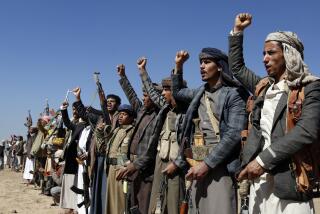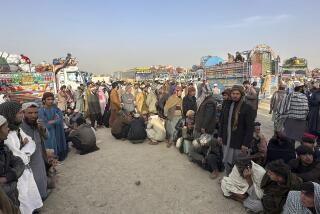Many freed Guantanamo inmates join terrorists, files say
Said Shihri, who was captured in Pakistan in late 2001 and became one of the first suspected terrorists held at Guantanamo Bay, was released six years later after he convinced U.S. officials that he would go home to Saudi Arabia to work in his family’s furniture store.
He emerged instead as the No. 2 leader of Al Qaeda in the Arabian Peninsula, a Yemen-based group that U.S. intelligence considers the world’s most dangerous terrorist organization.
Review panels at Guantanamo Bay also released at least six other detainees who later joined the militant group that has turned Yemen into a key battleground for Al Qaeda. One former detainee now is a prominent radical cleric, and another writes propaganda in English encouraging others to attack the United States.
Classified documents from Guantanamo Bay that were released to news organizations by WikiLeaks indicate U.S. officials repeatedly returned detainees to their home countries in hopes they would be incarcerated or be rehabilitated into society. Detainees returned to Saudi Arabia and Yemen have proved the most problematic.
Now, with Yemen roiled by street protests and political upheaval, U.S. intelligence officials worry that the former Guantanamo detainees will seek to capitalize on the turmoil to plot attacks against their former captors and other targets.
“It’s just a big frickin’ mess over there,” said a U.S. intelligence official, who was not authorized to speak in public.
U.S. counter-terrorism officials have relied on cooperation from President Abdullah Ali Saleh’s regime to battle Al Qaeda’s presence. But with public pressure mounting daily for Saleh’s swift ouster, the resultant chaos could produce an even larger opening for anti-Western militants.
Al Qaeda “will be more prolific in recruiting, and it could become easier to launch attacks from Yemen,” said the official. “That unrest could have the most impact on our domestic security.”
In Shihri’s case, although evidence indicated he had played an operational role in Al Qaeda, he denied to a review board at Guantanamo Bay that he had provided support to militants, and insisted he was “just a Muslim and not a terrorist.”
The review board approved his release in November 2007 into a special program in Saudi Arabia that has sought to rehabilitate former jihadists. Two years later, he appeared in an Al Qaeda video touting the merger of its Saudi Arabian and Yemeni branches, and he has since become deputy emir of Al Qaeda’s operations in Yemen.
Other cases also have raised alarms.
A former inmate named Uthman Ghamdi has used his detention as a recruiting tool. In Al Qaeda’s online English-language magazine, Inspire, Ghamdi recently described his time in Guantanamo and his flight from Saudi Arabia to join Al Qaeda in Yemen. He called on fellow Muslims to follow his footsteps into jihad.
Ibrahim Suleiman al Rubaish, a Saudi, spent five years at Guantanamo after he was captured by Pakistani officials in 2001. The review board assessment described him as “a Taliban fighter and Al Qaeda member.”
After he was released to the Saudi rehabilitation program, Rabaish made it to Yemen, where he now is believed to be a religious leader for the Al Qaeda group. In an audiotape last month attributed to Rubaish, he criticized President Saleh and the U.S. presence in Yemen and encouraged Yemeni soldiers to attack Western embassies. “Haven’t you seen the enemy’s embassies, which were only established to spy on and fight the Muslims?”
Officials say those cases are severe, but not unusual. Since the Guantanamo camp was established by the Bush administration after Sept. 11, 2011, U.S. officials say, 25% of the inmates released have rejoined Al Qaeda or other militant groups.
Of the 775 men who have been held at Guantanamo Bay since January 2002, 604 have since been transferred to other countries. Most of the 172 who remain have been rated “high risk” by the military.
“We always want to think there was a process or a procedure for releasing these guys. I am not sure there was,” said Christopher Boucek, an associate at the Washington-based Carnegie Endowment for International Peace think tank, who has tracked former detainees who have joined Al Qaeda in the Arabian Peninsula.
“Someone … will have to answer questions about why some of these guys were released,” said Boucek, who has studied the intelligence on detainees that was made public by WikiLeaks.
Officials in Washington have been under “a lot of pressure to clean out the zoo down there,” said a U.S. official familiar with the review process for detainees at Guantanamo. “[The review boards] probably have been leaning far too far forward”
Staff writers David C. Cloud and Ken Dilanian in Washington contributed to this report.
More to Read
Start your day right
Sign up for Essential California for news, features and recommendations from the L.A. Times and beyond in your inbox six days a week.
You may occasionally receive promotional content from the Los Angeles Times.







